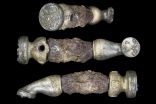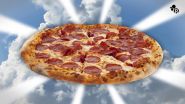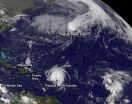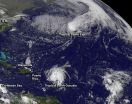(Press-News.org) Biomedical engineering researchers have developed a drug delivery system consisting of nanoscale "cocoons" made of DNA that target cancer cells and trick the cells into absorbing the cocoon before unleashing anticancer drugs. The work was done by researchers at North Carolina State University and the University of North Carolina at Chapel Hill.
"This drug delivery system is DNA-based, which means it is biocompatible and less toxic to patients than systems that use synthetic materials," says Dr. Zhen Gu, senior author of a paper on the work and an assistant professor in the joint biomedical engineering program at NC State and UNC Chapel Hill.
"This technique also specifically targets cancer cells, can carry a large drug load and releases the drugs very quickly once inside the cancer cell," Gu says.
"In addition, because we used self-assembling DNA techniques, it is relatively easy to manufacture," says Wujin Sun, lead author of the paper and a Ph.D. student in Gu's lab.
Each nano-cocoon is made of a single strand of DNA that self-assembles into what looks like a cocoon, or ball of yarn, that measures 150 nanometers across.
The core of the nano-cocoon contains the anticancer drug doxorubicin (DOX) and a protein called DNase. The DNase, an enzyme that would normally cut up the DNA cocoon, is coated in a thin polymer that traps the DNase like a sword in a sheath.
The surface of the nano-cocoon is studded with folic acid ligands. When the nano-cocoon encounters a cancer cell, the ligands bind the nano-cocoon to receptors on the surface of the cell – causing the cell to suck in the nano-cocoon.
Once inside the cancer cell, the cell's acidic environment destroys the polymer sheath containing the DNase. Freed from its sheath, the DNase rapidly slices through the DNA cocoon, spilling DOX into the cancer cell and killing it.
"We're preparing to launch preclinical testing now," Gu says. "We're very excited about this system and think it holds promise for delivering a variety of drugs targeting cancer and other diseases."
INFORMATION:
The paper, "Cocoon-Like Self-Degradable DNA-Nanoclew for Anticancer Drug Delivery," was published online Oct. 13 in the Journal of the American Chemical Society. Co-authors include Yue Lu, a Ph.D. student in Gu's lab; Margaret Reiff, an undergraduate student in the joint biomedical engineering department; Tianyue Jiang, a Ph.D. student in the joint biomedical engineering department and at the China Pharmaceutical University; and Dr. Ran Mo, a former postdoctoral researcher in the joint biomedical engineering department now at the China Pharmaceutical University.
This research was supported by the North Carolina Translational and Clinical Sciences Institute under grant number 1UL1TR001111 and with funding from NC State and UNC Chapel Hill.
Bio-inspired 'nano-cocoons' offer targeted drug delivery against cancer cells
2014-10-14
ELSE PRESS RELEASES FROM THIS DATE:
Cushing's syndrome: LCSB researchers characterize a new tumor syndrome
2014-10-14
Scientists at the Luxembourg Centre for Systems Biomedicine (LCSB) of the University of Luxembourg have published their findings that mutations in a gene known as "ARMC5" promote the growth of benign tumours in the adrenal glands and on the meninges: ARMC5 appears to belong to the group of so-called tumour suppressor genes. It is the first time in years that scientists have characterized such a gene.
The ARMC5 gene was discovered by independent workgroups studying benign tumours – so-called adrenal adenomas – in connection with Cushing's syndrome. In this ...
University of Leicester archaeologists discover bronze remains of Iron Age chariot
2014-10-14
University of Leicester archaeologists have made a "once-in-a-career" discovery of the decorated bronze remains of an Iron Age chariot.
A team from the University's School of Archaeology and Ancient History has unearthed a hoard of rare bronze fittings from a 2nd or 3rd century BC chariot which appears to have been buried as a religious offering.
The archaeologists found the remains during their ongoing excavation of the Burrough Hill Iron Age hillfort, near Melton Mowbray, Leicestershire.
The School has led a 5-year project there since 2010, giving archaeology students ...
Disputed theory on Parkinson's origin strengthened
2014-10-14
Parkinson's disease is strongly linked to the degeneration of the brain's movement center. In the last decade, the question of where the disease begins has led researchers to a different part of the human anatomy. In 2003, the German neuropathologist Heiko Braak presented a theory suggesting that the disease begins in the gut and spreads to the brain. The idea has since, despite vocal critics, gained a lot of ground. Researchers at Lund University in Sweden now present the first direct evidence that the disease can actually migrate from the gut to the brain.
The so-called ...
Magnetic superconductor: Strange bedfellows
2014-10-14
Chemists at Ludwig-Maximilias-Universitaet (LMU) in Munich have synthesized a ferromagnetic superconducting compound that is amenable to chemical modification, opening the route to detailed studies of this rare combination of physical properties.
Superconductivity and ferromagnetism – the "normal" form of magnetism, such as that found in the familiar horseshoe magnet – are like chalk and cheese: They generally don't go together. Ferromagnets are magnetic because the parallel alignment of adjacent electron spins in the iron atoms generates a strong internal ...
Rising sea levels of 1.8 meters in worst-case scenario
2014-10-14
The climate is getting warmer, the ice sheets are melting and sea levels are rising – but how much? The report of the UN's Intergovernmental Panel on Climate Change (IPCC) in 2013 was based on the best available estimates of future sea levels, but the panel was not able to come up with an upper limit for sea level rise within this century. Now researchers from the Niels Bohr Institute and their colleagues have calculated the risk for a worst-case scenario. The results indicate that at worst, the sea level would rise a maximum of 1.8 meters. The results are published ...
The chemistry of pizza (video)
2014-10-14
WASHINGTON, Oct. 13, 2014 — Whether it's a plain cheese, a deep-dish stacked with meats or a thin-crust veggie delight, there's just something about pizza that makes it delicious. There's a lot of chemistry that goes into everything from dough to sauce to toppings to, of course, cheese. There's also a very specific chemical reaction at work on every single slice, no matter what toppings you choose. Check out the latest episode here: http://youtu.be/tOkCgAwhh9U.
Subscribe to the series at Reactions YouTube, and follow us on Twitter @ACSreactions to be the first to ...
Oral drug reduces formation of precancerous polyps in the colon, UB researchers find
2014-10-14
BUFFALO, N.Y. — An oral biologic medication has successfully treated chronic, precancerous inflammation in the intestine, according to results of an animal study authored by an MD/PhD student in the University at Buffalo School of Medicine and Biomedical Sciences.
The study is featured on the cover of the current issue of Cancer Research; it was published online ahead of print in September. The journal's editors characterized the study's findings as "striking."
Inflammatory cells in the colon, or polyps, are very common after the age of 50. The average 60-year-old ...
NASA satellite sees wind shear affecting Tropical Storm Vongfong
2014-10-14
Tropical Storm Vongfong continues to weaken as it tracks across the big islands of Japan, and NASA satellite data showed that westerly wind shear is taking its toll on the storm's structure.
On Oct. 12 at 0500 UTC (1 a.m. EDT), the MODIS instrument aboard NASA's Aqua satellite captured an image of Tropical Storm Vongfong approaching Japan. Despite weakening to a tropical storm, Vongfong still appeared to have an eye as its northeastern quadrant blanketed the large island of Kyushu, Japan. By 11 a.m. EDT, Maximum sustained winds had dropped to 55 knots (63 mph/102 kph). ...
Tropical Storm Gonzalo triggered many warnings in Eastern Caribbean
2014-10-14
The Eastern Caribbean islands were getting the brunt of Tropical Storm Gonzalo as the storm slowly moved through on Oct. 13. NASA's Terra satellite and NOAA's GOES-East satellite provided data on the storm. Gonzalo is the sixth named storm in the Atlantic Ocean Hurricane Season.
On Oct. 12 at 15:00 UTC (11:00 a.m. EDT), NASA's Terra satellite flew over Tropical Storm Gonzalo while it moved over the Lesser Antilles. The MODIS instrument captured a visible image of the storm that showed a concentration of strong thunderstorms around the center of circulation and in a thick ...
Satellites confirm Fay weakened to a Tropical Storm
2014-10-14
The fifth named Atlantic storm didn't maintain hurricane status long. Fay became a hurricane late on Oct. 12 and by early on Oct. 13, had weakened back to a tropical storm.
A visible image from NOAA's GOES-East satellite on Oct. 13 at 1145 UTC (7:45 a.m. EDT) showed Tropical Storm Fay northeast of Bermuda and Tropical Storm Gonzalo over the Lesser Antilles. Fay appeared circular, but didn't have the signature shape of a tropical storm like Gonzalo, with bands of thunderstorms spiraling into the center. The image was created by the NASA/NOAA GOES Project at NASA's Goddard ...






